A big draw of freelance UX writing is the ability to make bank while working a lot less. The best way to get there? Mastering value-based pricing.
Value-based pricing is a pricing strategy that uses an understanding of what your project is worth to the client to figure out a fair price.
An overly-simple example:
A client comes to you looking for an email welcome series. After asking the client a series of specific, business-based questions, you learn this welcome series will make the client $10,000 in new sales. You think it's fair to get paid for the value you're creating over, say, an hourly rate, and decide getting 20% of the added value would be fair. Ipso facto, your price for the project is $2,000.
Value-based pricing is da bomb because:
- It shifts the conversation from a pricing discussion to a value discussion: You're talking about business growth, not dollars and cents.
- You can make wayyy more: 10 hours at $100 an hour is half of what you'd get paid with value-based pricing for the email welcome series.
- You're not exchanging time for money: Because time doesn't equal money.
The best part? The pricing strategy works because it puts you on the same page as your client.
For example, there's a discrepancy between your goals and a client's goals with the most common pricing methods:
Hourly goals:
- Client: Minimize time on project, minimize cost
- Freelancer: Maximize time on project, maximize income
Flat-fee goals:
- Client: Get the most work for the best price
- Freelancer: Work fast, maximize effective hourly rate
But with value-based pricing, the goals align:
Value-based goals:
- Client: Reach business goals, minimize risk, get maximum value
- Freelancer: Achieve client's goal, make the right solution, deliver most value
And you get paid more to be on the same page.
$100,000 proposals don’t come from an hourly rate or a flat-fee — I couldn't sell it if I used that kind of pricing strategy.
Instead, if a client stands to make $1M if the project achieved their goals, it'd only be fair to get 10% of that growth to help them reach that goal.
You need to show the value you can create and how that ties to their goals happening.
To create a value-based proposal, you'll:
- Sleuth during your sales call
- Decide on a value-based price
- Write your sales document (aka proposal)
If you're ready to jump in full force, let me explain…
1. Sleuth during your sales call
Your sales call has multiple purposes (hint: none of them are to explain your process.)
Arguably, the most important purpose of your sales call is to understand how to price the project using value-based pricing.
The idea is you ask some very specific questions on your sales call to get a sense of the client's goals and what they stand to gain from the project.
Some questions might be:
- What’s the current situation?
- Why do you want to do this project this way?
- What alternatives did you consider?
- Why is this a priority now?
- Has something changed? Can it wait?
- Why did you reach out to me instead of someone else? Why not outsource overseas?
- What goals or outcomes do you want?
- What are your non-negotiable?
- What are your expectations of the work?
- How should your business improve as a result of this?
- What would happen if you did nothing?
- What does the success of the project look like?
- What's the cost of failure?
- How will we measure success?
- Will this project have a monetary impact on the company?
- What financial impact will achieving your goal have on your business?
- What's your current annual recurring revenue?
Some tricky, uncomfortable questions to ask… But it becomes casual and second-nature with time.
With these questions, you're looking to understand:
- How painful is the problem they're looking to solve? (more pain = higher price)
- How urgently do they need to solve it? (faster = higher price)
- How excited are they about you? (more excited = higher price)
- How much $$$ do they stand to gain? (more upside = higher price)
You don't have to ask all of these questions — that'd be a very intense conversation ;)
Instead, have this list of questions next to you, and ask them as they feel relevant. If you leave the conversation with a clear picture of how much they care about the problem and working with you, you'll be in good hands.
PS: Having this conversation is kind of like jazz. You have to be OK and ready to go with the flow and adlib as you go.
2. Decide on a value-based price
Once you learn how much the client stands to gain, decide what a comfortable and fair cut of it would be for you.
There are many way to go about value-based pricing, but I like to start with the base-level price of the project.
To get to the base-level price, take your hourly rate and multiply it by the number of hours you estimate the project will take.
For example, if my hourly rate is $150, and the project will take 20 hours, my base-level price is $3,000.
Once you have your base-level price, think back to your conversation with the client and ask yourself:
- Does this price reflect how painful the problem is for the client?
- Does this price relflect how urgently they need to solve the problem?
- Does this price reflect how excited the client is to work with me?
- Does this price fairly reflect how much $$$ the client will make from success?
Based on your answers to those questions, move your price up and down. If it's a very painful problem for the client and they need it done yesterday, maybe up your price to $8,000. And if they're set on working with you, tack on anther $2k.
Remember the price your start with isn't set in stone. If they say it's too much, you can walk it back and say, "Would you do it for $X,XXX instead?" The only thing you can't walk back from is underpricing.
3. Write your sales document (aka proposal)
Once you have your price, it's time to get to selling.
A proposal is a sales asset. It's not a formal document. It's not a brief. It shouldn't act or sound like one.
The only goal of your proposal is to sell your project.
You do that by:
- Being clear and concise
- Answering all asked questions
- Answering all unanswered questions
- Reiterating your pitch
- Making it crystal-clear you’re all on the same page
A big misunderstanding is your proposal ties a bow on things and seals the deal. You haven't landed the gig until the client signs on the dotted line. I'm here to tell you the traditional proposal you think you should create isn't what your clients want to read.
Let me explain. Imagine you're replacing your roof. Two different contractors, Roofer Ron and Builder Bill, come out to take a look. You have similar conversations with both, and they say they'll follow up with a proposal. Understandably, you know squat about roofing. All you know is you need a new roof.
Roofer Ron sends you a straightforward proposal. It looks something like this:
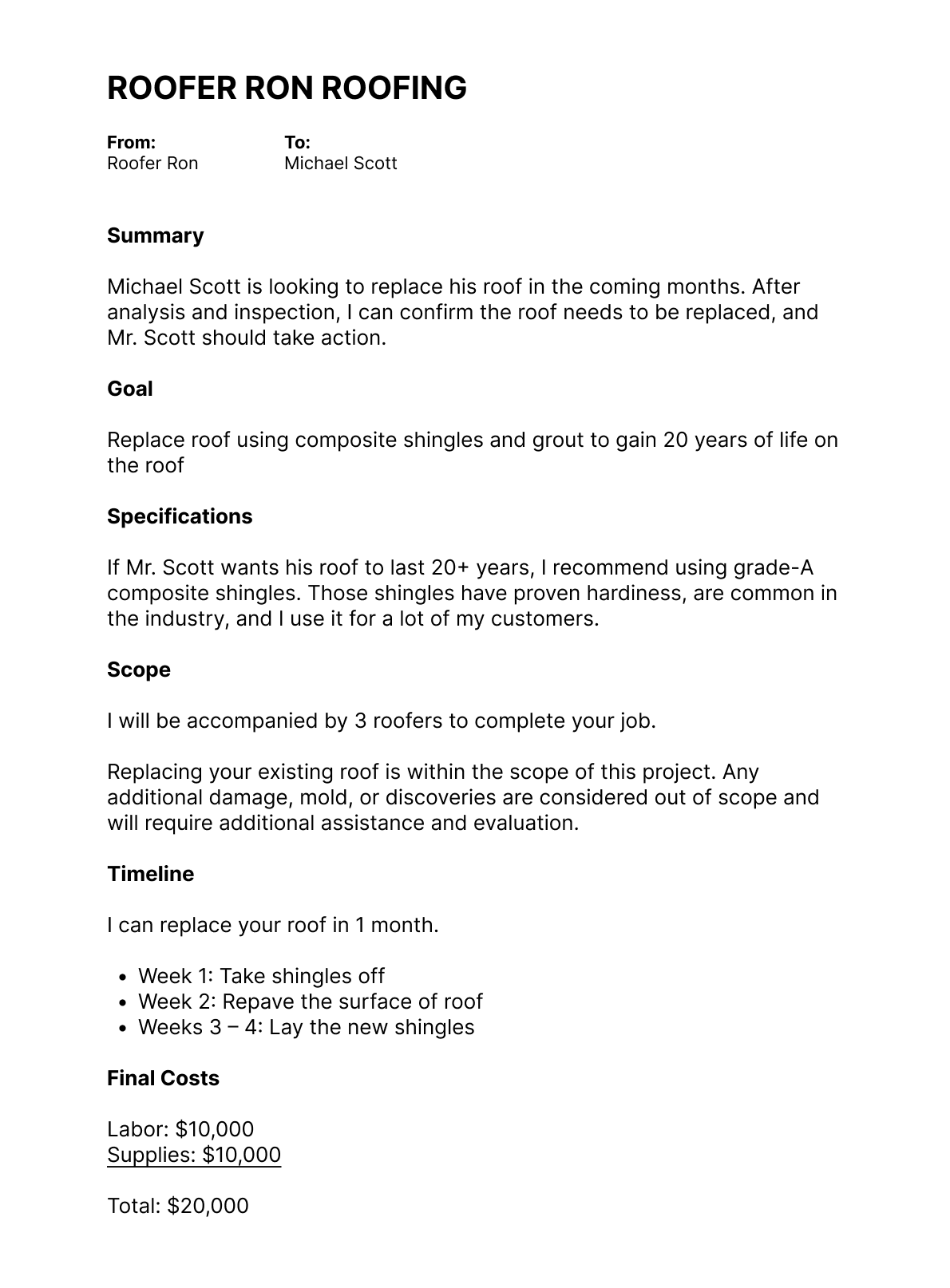
Pretty straightforward. Now, it's not a bad proposal. But, Builder Bill knows a bit more about sales and took the time to get into our mindset.
Take a look at what he put together:
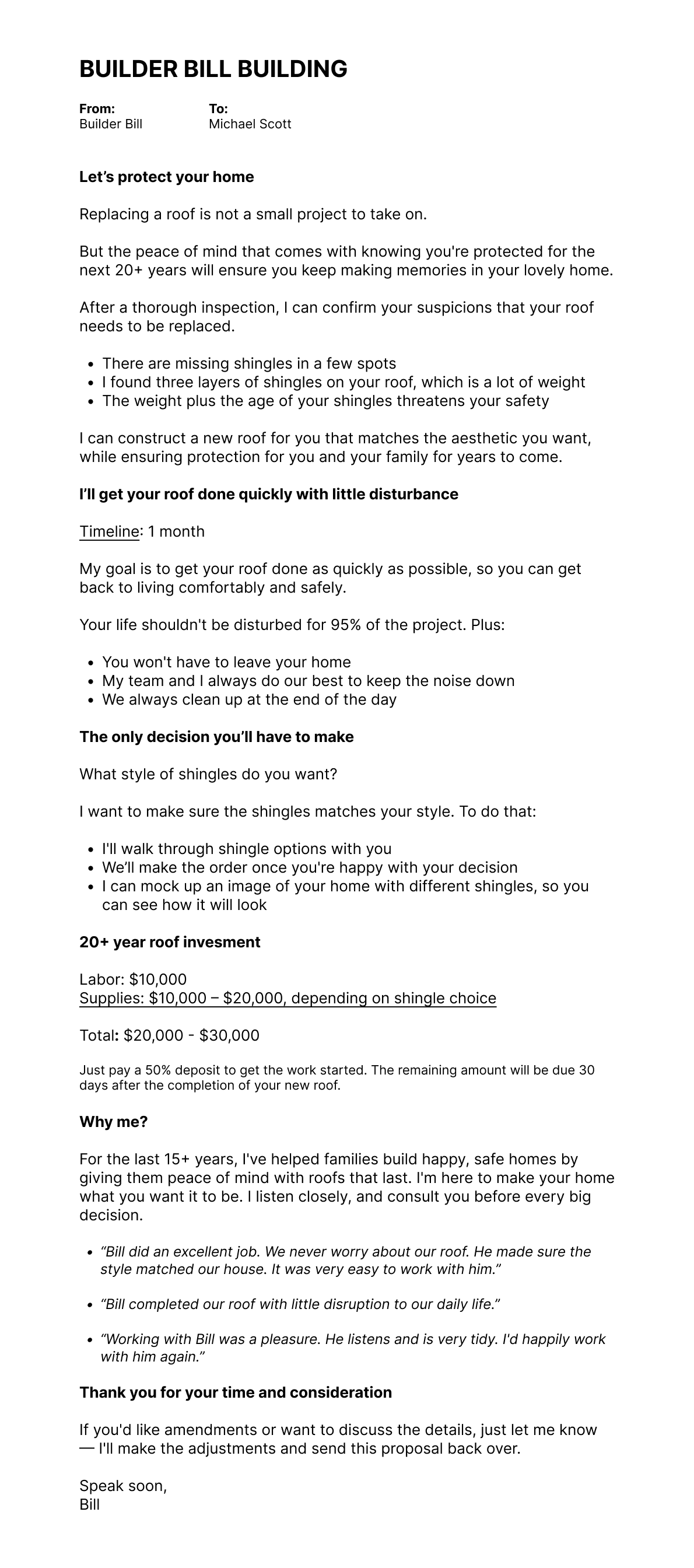
Builder Bill took the time to deeply understand what we, the customer, care about. We want our life to stay as normal as possible and for the roof to look good and work. We don't give a rat's ass about shingle material or grout type.
This is the same for your clients. Remember, they're looking for a freelancer to solve their problem. Your proposal is all about them and actually has very little to do with you.
I assume most of you aren't roofers, so I'll lay out the sections that go into a proposal you might actually use and some tips to consider.
The introduction
Don't start with the word “summary.” The first line someone reads in your proposal should draw them in. They're probably coming at it in the mindset of skimming, so you need to hook them. And make it about them.
For example, if you're a UX writer redesigning an onboarding flow, a headline could read, “Consider your onboarding drop-off solved.” Much more enticing than “summary.”
You always want to put the important details in the headline. Don't make people dig for them. The first paragraph is your opportunity to set the tone for the rest of your pitch. You need to show that you:
- Understand their problem
- Understand how to solve it
- Will be enjoyable to work with
You don't need to repeat their KPIs verbatim.
Continuing with the UX writer example, your introduction might read like:
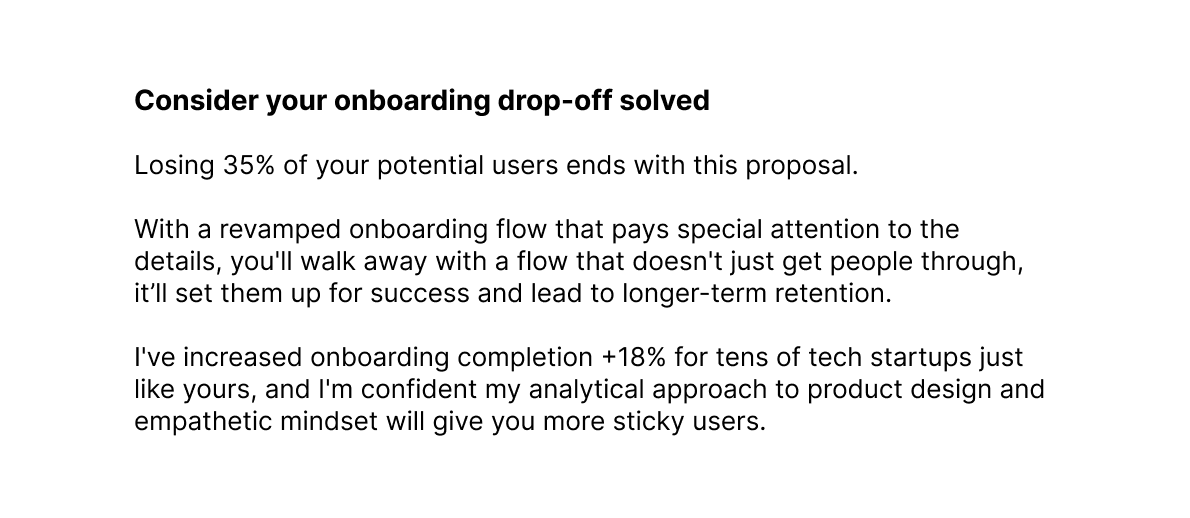
How we’ll get the job done
So, you've hooked someone with your introduction. Now it's time to get more into the nitty-gritty, but not too much.
Again, the potential client wants to feel confident you can solve their problem, but too many specifics can go over their head. Here, you want to include your timeline and touch on how different phases work toward solving their problem in an effective and efficient way.
Let's take a look at what this UX writer would say:
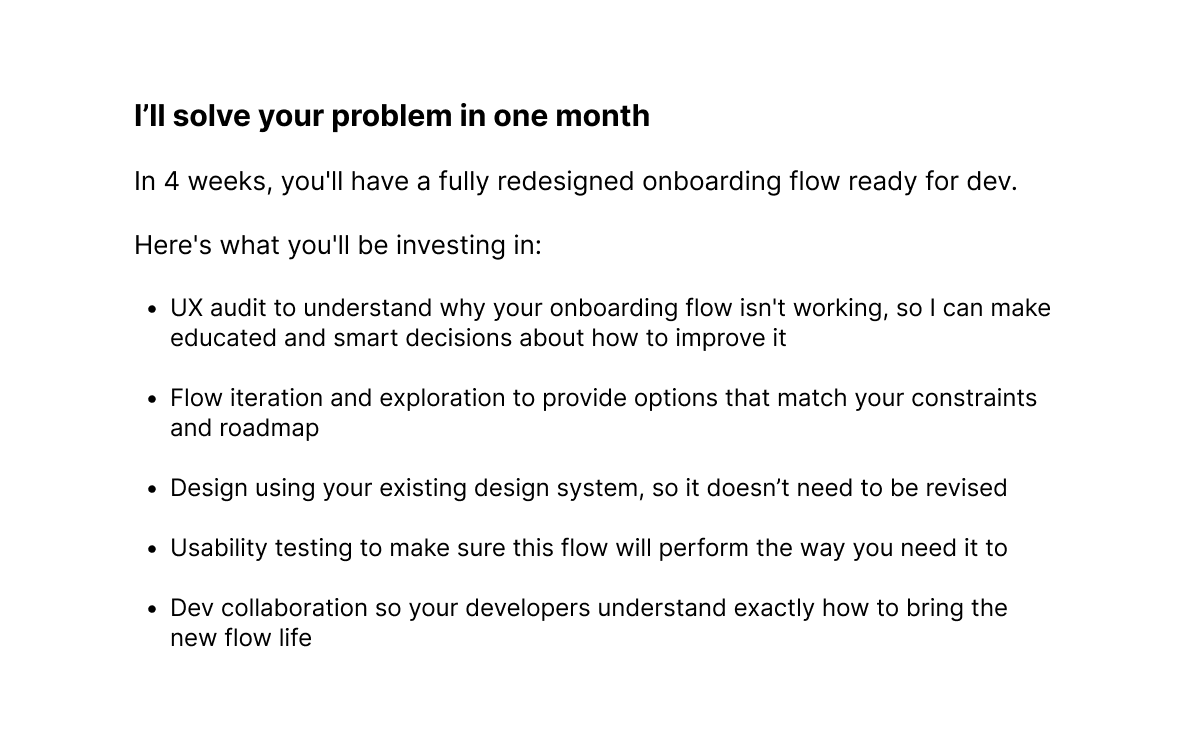
Notice how this fictitious UX writer didn't dive into lofi and hifi design phases. Does the CEO of a 3-person startup really know the difference between lofi and hifi, or even care? If we were sending this proposal to a product design director, that'd be important to include to show we know our stuff.
Remember, you're writing this for a person, and you need to understand their world view.
Investment
Don't say “costs” or “fees.” No one wants to pay for something. But they do want to invest in something. Framing matters.
Here, you want to keep it pretty straightforward. Say your price and shut up. Don't break down the price too much, because clients can start to nitpick. And include your standard payment schedule and terms (net 30, etc.,) so they know what to expect.

Why me
Again, your proposal is a sales asset. Don't assume your potential client fully remembers everything from your sales call and your website. They may not read this proposal word-for-word, so it doesn't hurt to back yourself up.
This section is your opportunity to explain your credibility and why you're the best person for the job. Make sure it's catered to where this company sits and their position in the market.
For example, if you're sending this proposal to a crypto startup, saying you've done work for fintechs ranging from Coinbase to “stealth startup” shows you understand their industry and their speed.
If you don't have experience in their industry, comment on the size of the company or how you've achieved similar goals in general. This is also where you should include testimonials and link to your case studies.
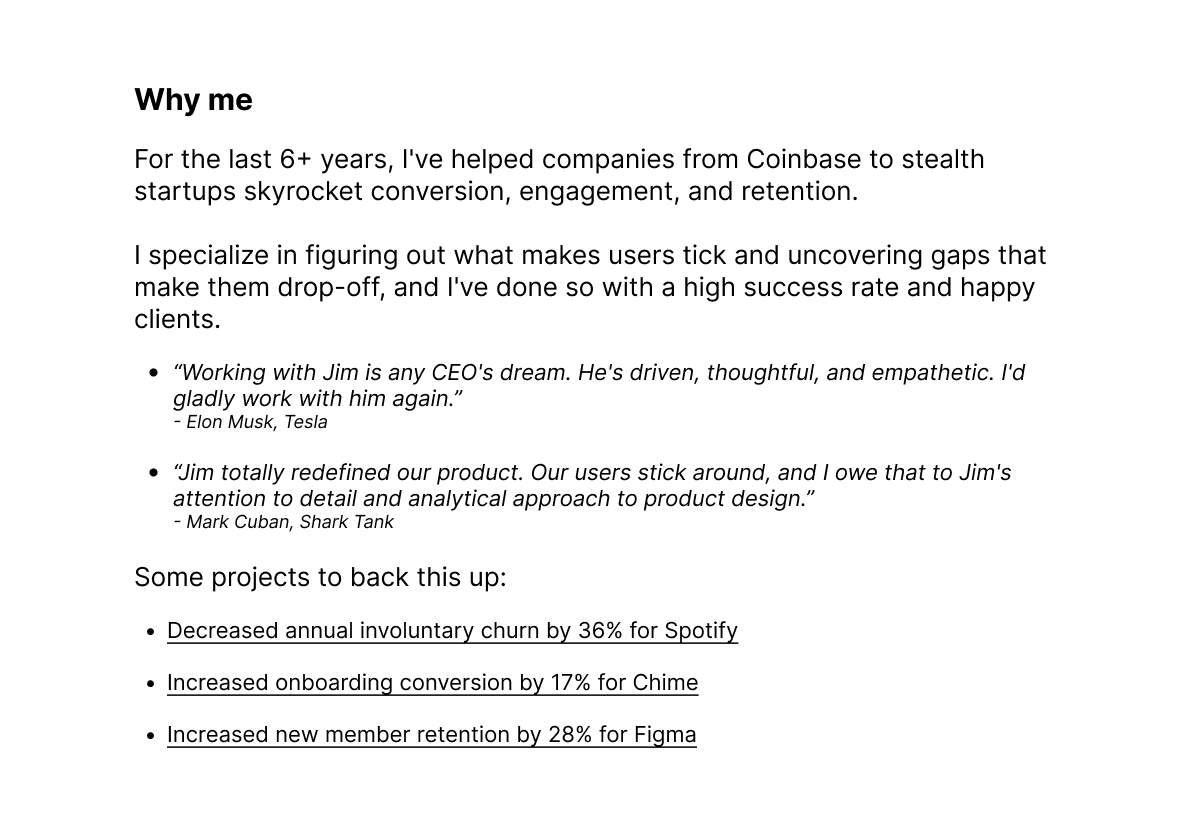
Thank you
It never hurts to thank your potential client for taking the time to read what you put together. It makes you look human and the whole thing less transactional.
It doesn't have to be long or over the top, and I think signing your name also gives it a nice touch.
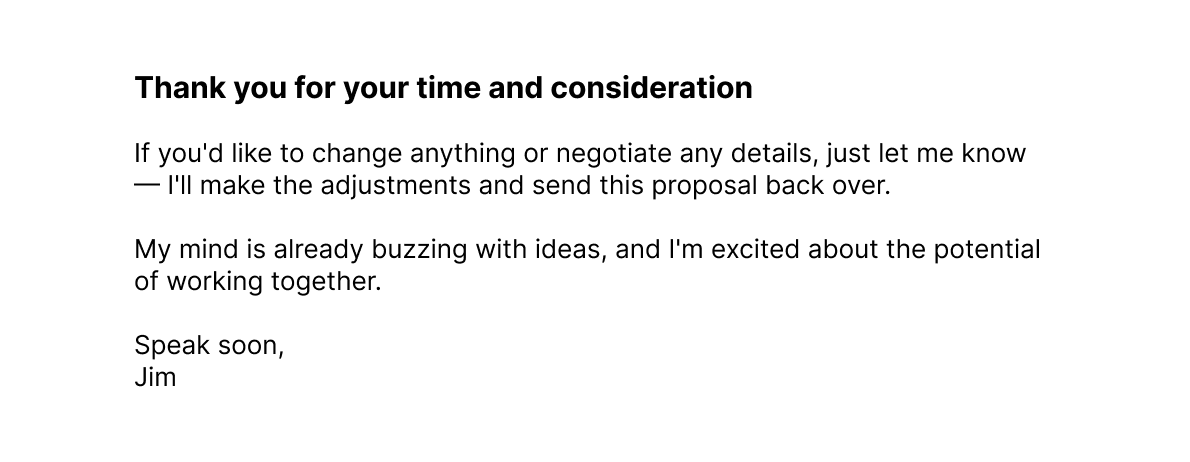
And that's your winning proposal. Writing proposals like this will make you stick out like a sore thumb (in a good way.)
Don’t forget to make sure your proposal matches your personal brand. Writing proposals that sell takes work and customization, but it literally pays off.
There you have it 🤗 Now, get to selling ;)
Happy UX writing 🖖
-Slater
Want more in-depth UX writing how-tos?
Own all The Gig Gal UX writing tutorials plus UX writing exercises, job search and freelance advice, and much more with your copy of The Gig Gal UX Content Career Course.





